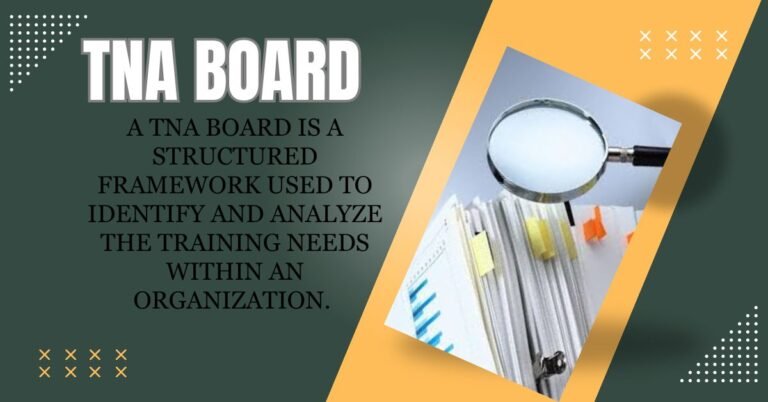Effective team assessment is crucial for any organization striving for success and growth. One powerful tool for this purpose is the TNA (Training Needs Analysis) Board. Understanding and utilizing the TNA Board effectively can significantly enhance your team’s performance and development. This article delves into mastering the TNA Board, providing valuable insights into its implementation, benefits, and best practices.
Table of Contents
ToggleUnderstanding the TNA Board
What is a TNA Board?
A TNA Board’s is a structured framework used to identify and analyze the training needs within an organization. It helps in pinpointing gaps in skills, knowledge, and performance, thereby guiding the development of targeted training programs. The board typically consists of a visual representation of the team’s competencies, areas for improvement, and specific training requirements.
Why Use a TNA Board?
The TNA Board’s provides several advantages, including:
- Clarity: Offers a clear view of the current skill levels and training needs of team members.
- Focused Training: Helps in designing training programs that address specific gaps and enhance overall performance.
- Resource Optimization: Ensures that training resources are allocated effectively, reducing waste and maximizing impact.
Implementing the TNA Board
1. Defining Objectives
Before setting up the TNA Board’s, clearly define the objectives of your assessment. What are you hoping to achieve? Objectives might include improving team performance, addressing skill gaps, or preparing for future challenges. Clearly defined goals will guide the entire assessment process.
2. Gathering Data
Collect data on your team’s current skills, knowledge, and performance levels. This can be achieved through various methods such as surveys, interviews, performance reviews, and self-assessments. Ensure the data collected is comprehensive and representative of the entire team.
3. Analyzing Data
Once data is collected, analyze it to identify key areas where training is needed. Look for patterns and trends that indicate common skill gaps or performance issues. This analysis will form the basis of your TNA Board and help in prioritizing training needs.
4. Designing the TNA Board
Create a visual representation of the data, typically using a board or software tool. The TNA Board should include:
- Skill Categories: Different areas of skills and competencies relevant to your team.
- Current Skill Levels: Assessment of each team member’s proficiency in various skill categories.
- Training Needs: Identified gaps where additional training is required.
- Prioritization: Prioritized list of training needs based on their impact on team performance.
5. Developing Training Programs
With the TNA Board’s as your guide, develop targeted training programs that address the identified needs. Ensure that the programs are practical, engaging, and tailored to the specific requirements of your team. Consider a mix of training methods, such as workshops, e-learning, and on-the-job training.
6. Monitoring and Evaluation
After implementing the training programs, continuously monitor their effectiveness. Gather feedback from team members, track performance improvements, and make necessary adjustments to the training programs. Regular evaluation ensures that the training remains relevant and effective.
Best Practices for Using the TNA Board
1. Involve the Team
Involve team members in the assessment process to ensure accuracy and buy-in. Their input can provide valuable insights into their own training needs and help in creating a more comprehensive TNA Board’s.
2. Keep It Dynamic
The TNA Board’s should be a living document that evolves with your team’s needs. Regularly update it to reflect changes in skills, performance, and training requirements. This dynamic approach ensures that the TNA Board remains relevant and useful.
3. Align with Organizational Goals
Ensure that the training needs identified through the TNA Board’s align with your organization’s overall goals and objectives. Training should support broader business strategies and contribute to the achievement of organizational targets.
4. Communicate Clearly
Clearly communicate the purpose and benefits of the TNA Board and related training programs to your team. Transparency helps in gaining support and commitment from team members, making the training process more effective.
5. Leverage Technology
Utilize technology to enhance the TNA Board’s functionality. Software tools and platforms can streamline data collection, analysis, and reporting, making the assessment process more efficient and accurate.
Case Study: Successful Implementation of the TNA Board
Company Overview
XYZ Corporation, a leading technology firm, faced challenges with skill gaps and inconsistent performance across its development teams. To address these issues, the company decided to implement a TNA Board to identify and address training needs.
Implementation Process
- Objective Definition: XYZ Corporation aimed to improve team performance and align skills with emerging technologies.
- Data Collection: Surveys, performance reviews, and skill assessments were conducted across development teams.
- Data Analysis: The data revealed gaps in advanced programming skills and project management competencies.
- TNA Board Design: A comprehensive TNA Board was created, highlighting skill gaps and prioritizing training needs.
- Training Programs: Targeted training programs were developed, including advanced coding workshops and project management courses.
- Monitoring: Regular feedback was gathered, and training programs were adjusted based on performance improvements.
Conclusion
Mastering the TNA Board’s is a powerful strategy for effective team assessment and development. By understanding its purpose, implementing it correctly, and following best practices, organizations can enhance their teams’ skills and performance. The TNA Board provides a clear, structured approach to identifying training needs and designing targeted programs, ultimately contributing to the success and growth of the organization. Embrace the TNA Board as a key tool in your team development strategy and unlock the full potential of your workforce.
ALSO READ: Whispers on Paper: The Art of Erotic Letters

